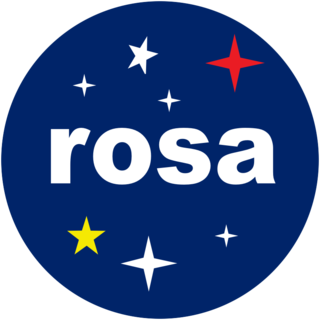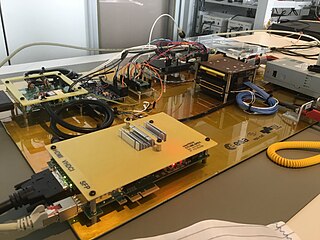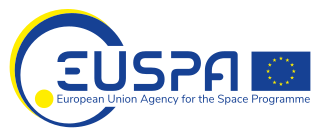
The European Space Operations Centre (ESOC) serves as the main mission control centre for the European Space Agency (ESA) and is located in Darmstadt, Germany. ESOC's primary function is the operation of uncrewed spacecraft on behalf of ESA and the launch and early orbit phases (LEOP) of ESA and third-party missions. The Centre is also responsible for a range of operations-related activities within ESA and in cooperation with ESA's industry and international partners, including ground systems engineering, software development, flight dynamics and navigation, development of mission control tools and techniques and space debris studies.
The Satellite Control and Operation System 2000 (SCOS-2000) is the generic satellite Mission Control System (MCS) software infrastructure developed and maintained by the European Space Agency (ESA/ESOC) in collaboration with European industry and deployed for missions such as Radarsat 2, XMM-Newton, INTEGRAL, Cryosat, Mars Express, Venus Express, GOCE, Herschel, Planck, Rosetta, Cryosat-2, Galileo, MetOp, LISA Pathfinder, SWARM, Gaia, SENTINEL spacecraft or EXOMARS orbiters. Upcoming missions that will deploy SCOS-2000 include MetOp-SG, METEOSAT Third Generation, Aeolus, EarthCARE, BepiColombo, SOLO or EUCLID.

Copernicus is the Earth observation component of the European Union Space Programme, managed by the European Commission and implemented in partnership with the EU Member States, the European Space Agency (ESA), the European Organisation for the Exploitation of Meteorological Satellites (EUMETSAT), the European Centre for Medium-Range Weather Forecasts (ECMWF), the Joint Research Centre (JRC), the European Environment Agency (EEA), the European Maritime Safety Agency (EMSA), Frontex, SatCen and Mercator Océan.

The Romanian Space Agency is a public institution with extra-budgetary funding that coordinates Romania's national space technology research programs and space research-related activities. ROSA was founded in 1991 and is subordinate to the Ministry of Education.
The Spacecraft Monitoring & Control (SM&C) Working Group of the Consultative Committee for Space Data Systems (CCSDS), which sees the active participation of the main space agencies, is defining a service-oriented architecture consisting of a set of standard end-to-end services between functions resident on board a spacecraft or based on the ground, that are responsible for mission operations.
The Spacecraft Monitoring & Control (SM&C) Working Group of the Consultative Committee for Space Data Systems, which sees the active participation of 10 space agencies and of the Space Domain Task Force of the Object Management Group, is defining a service-oriented architecture consisting of a set of standard end-to-end services between functions resident on board a spacecraft or based on the ground, that are responsible for mission operations.

Euclid is a wide-angle space telescope with a 600-megapixel camera to record visible light, a near-infrared spectrometer, and photometer, to determine the redshift of detected galaxies. It was developed by the European Space Agency (ESA) and the Euclid Consortium, and was launched on 1 July 2023.
The Spacecraft Monitoring & Control (SM&C) Working Group of the Consultative Committee for Space Data Systems, which sees the active participation of 10 space agencies and of the Space Domain Task Force of the Object Management Group, is defining a service oriented architecture consisting of a set of standard end-to-end services between functions resident on board a spacecraft or based on the ground, that are responsible for mission operations.
The Consultative Committee for Space Data Systems (CCSDS) was founded in 1982 for governmental and quasi-governmental space agencies to discuss and develop standards for space data and information systems. Currently composed of "eleven member agencies, twenty-eight observer agencies, and over 140 industrial associates," the CCSDS works to support collaboration and interoperability between member agencies through the establishment of data and system standards. According to the organisation's website, more than 1000 space missions have utilized data and systems standards created by CCSDS. The activities of the CCSDS are organized around six topic areas and composed of many working groups within the overall Collaborative Working Group Environment (CWE).

OPS-SAT is a CubeSat by the European Space Agency (ESA) and it is intended to demonstrate the improvements in mission control capabilities that will arise when satellites can fly more powerful on-board computers. The mission has the objective to break the cycle of "has never flown, will never fly" in the area of satellite control. It was the first CubeSat operated directly by ESA.
NanoAvionics Corp is a small satellite bus manufacturer and mission integrator founded as a spin-off from Vilnius University, Lithuania in 2014.
Telespazio Germany GmbH is a European aerospace company, founded in 1978. The company provides consulting, technology and engineering services in aerospace missions for ESOC, EUMETSAT and the German Aerospace Center (DLR).
GomSpace is a manufacturer and operator of nanosatellites for customers in the defense, academic, government and commercial markets. GomSpace's services include systems integration, nanosatellite platforms, constellation operations management and miniaturised radio technology. The company serves customers in more than 50 countries.

The European Union Agency for the Space Programme (EUSPA) is a space agency, managing the European Union Space Programme as one of the agencies of the European Union (EU). It was initially created as the European Global Navigation Satellite Systems Supervisory Authority (GSA) in 2004, reorganised into the European Global Navigation Satellite Systems Agency in 2010, and established in its current form on May 12, 2021. EUSPA is a separate entity from the European Space Agency (ESA), although the two entities work together closely.

The Advanced Ground Software Applications Laboratory at the European Space Agency has the objective of investigating and prototyping advanced software concepts and technologies that enable the evolution of mission data systems for future space missions.
Space Applications Services is an independent Belgian company founded in 1987, with a subsidiary, Aerospace Applications North America, in Houston, USA. Its aim is to research and develop innovative systems, solutions and products and provide services to the aerospace and security markets and related industries. Its activities cover crewed and uncrewed spacecraft, launch/re-entry vehicles, control centres, robotics and a wide range of information systems. The company is EN 9100 certified and serves clients worldwide. It is owned and managed by its founders, Richard Aked and Leif Steinicke.
The European Ground System - Common Core (EGS-CC) is a European initiative to develop a common infrastructure to support the development of ground space systems for space missions.
Phi-Sat-1 is a CubeSat mission from the European Space Agency (ESA) that uses Artificial Intelligence (AI) for Earth observation. The mission will collect a large number images from space in the visible, near-infrared and thermal-infrared parts of the electromagnetic spectrum, and then filter out the images which are covered with clouds using AI algorithms. This reduces the number of images to be downlinked from space and therefore improve efficiency. The Phi-Sat-1 mission has two main objectives:
The Lume-1 is a Spanish nanosatellite developed for educational and scientific purposes by the University of Vigo in cooperation with Alén Space, the University of Porto and the French National Centre of Scientific Research. The satellite is part of the Fire-RS program in order to battle wildfires.
Phi-Sat-2 is an Earth observation CubeSat mission from the European Space Agency (ESA) platform capable of running AI apps directly on board. What makes Phi-Sat-2 particularly noteworthy is its utilization of the NanoSat MO Framework, a modular and open-source platform designed for small satellite missions.






